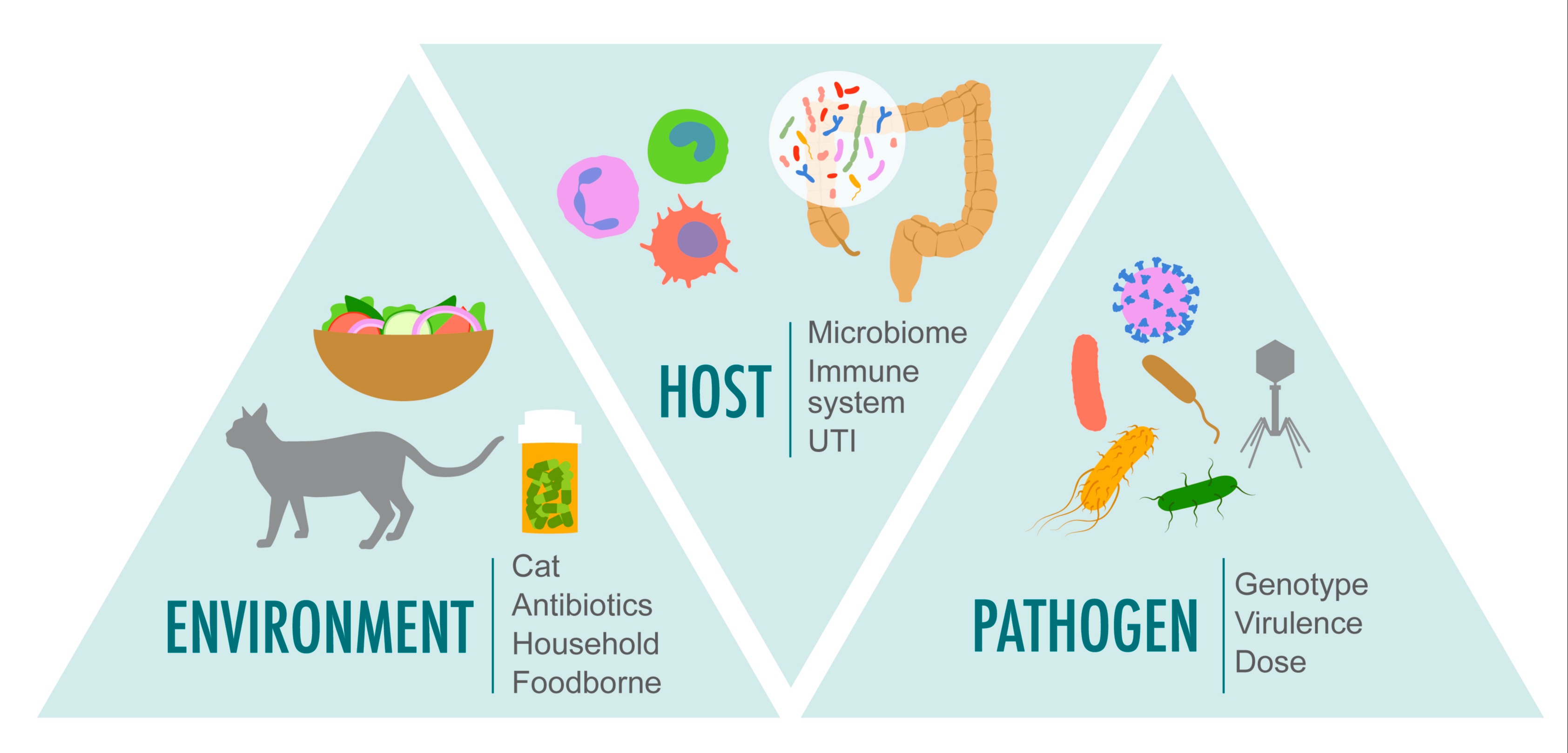Back
Poster Session C - Monday Afternoon
C0109 - Look What the Cat Dragged In! Community-Acquired Clostridiodes difficile Infection From a Household Cat
Monday, October 24, 2022
3:00 PM – 5:00 PM ET
Location: Crown Ballroom

Manuel Garza, MD, MS
Houston Methodist Hospital
Houston, TX
Presenting Author(s)
Manuel Garza, MD, MS1, Braden Thomas, MD1, Adam A. Saleh, BS2, Eleonora Avenatti, MD1, Lara Nabbout, MD1, Neha Mathur, MD1, Eamonn M. Quigley, MD, MACG1
1Houston Methodist Hospital, Houston, TX; 2Engineering Medicine at Texas A&M Health Science Center Medical School, Houston, TX
Introduction: Risk factors for Clostridiodes difficile infections (CDI) classically include antibiotic exposure, hospital or nursing home stays, inflammatory bowel disease, or weakened immune systems. However, there is an increasing incidence of community-associated CDI (CA-CDI) in persons without these risk factors. This rise in incidence has implicated natural reservoirs, such as zoonosis. Our case describes a recurrent CA-CDI acquired from a household cat.
Case Description/Methods: 31-year-old woman with one week of fever and diarrhea, reporting 4 loose, non-bloody bowel movements per day, associated with abdominal cramps, nausea, and vomiting. Medical history included endometriosis and recurrent urinary tract infections (UTIs) . She completed 7 days of ciprofloxacin 3 days prior to presentation. She denied prior hospitalizations, surgeries, enteric infections, or family history of immune-mediated conditions or IBD.
Physical exam: T 102 F, HR 133 BPM, RR 22 BPM, normotension, minimal abdominal tenderness and no guarding. WBC count was 13,950 cells/μL, lactic acid 2.8 mg/dL, and UA revealed a trace leukocyte esterase. Urine culture was negative, but she received 2 days of IV antibiotics for a suspected UTI. Stool PCR was positive for C. difficile and she received oral vancomycin for 14 days. 1 month later, a trial taper of vancomycin and fidaxomicin was given for recurrent C. difficile. Of note, she adopted a stray cat one month prior to symptom onset; her cat’s stool tested positive for C. difficile. 5 months after the initial infection, she was referred for colonoscopy and treated with bezlotoxumab with minimal improvement; now with a plan to pursue FMT.
Discussion: C. difficile acquisition from a household cat represents a novel presentation of CA-CADI. The interaction between the host, their environment, and the infectious agent is key to this case. (fig. 1) In this case we believe that antibiotic use permitted seeding of her GI tract by C. difficile acquired from her cat. This is supported by the close temporal relationship between the cat’s adoption and symptom onset. Evidence that humans can pass C. difficile to cats makes it more likely that her multiple recurrent CA-CDIs derived from this natural reservoir. This case emphasized the importance of history taking, contact (pet) tracing, reduction in excessive antibiotic use and proper instruction on sterilization of household surfaces in recurrent CA-CDI.
1. Tsai, C.S, et al, Clostridioides difficile infection: an emerging zoonosis?, 2021,1543-1552

Disclosures:
Manuel Garza, MD, MS1, Braden Thomas, MD1, Adam A. Saleh, BS2, Eleonora Avenatti, MD1, Lara Nabbout, MD1, Neha Mathur, MD1, Eamonn M. Quigley, MD, MACG1. C0109 - Look What the Cat Dragged In! Community-Acquired Clostridiodes difficile Infection From a Household Cat, ACG 2022 Annual Scientific Meeting Abstracts. Charlotte, NC: American College of Gastroenterology.
1Houston Methodist Hospital, Houston, TX; 2Engineering Medicine at Texas A&M Health Science Center Medical School, Houston, TX
Introduction: Risk factors for Clostridiodes difficile infections (CDI) classically include antibiotic exposure, hospital or nursing home stays, inflammatory bowel disease, or weakened immune systems. However, there is an increasing incidence of community-associated CDI (CA-CDI) in persons without these risk factors. This rise in incidence has implicated natural reservoirs, such as zoonosis. Our case describes a recurrent CA-CDI acquired from a household cat.
Case Description/Methods: 31-year-old woman with one week of fever and diarrhea, reporting 4 loose, non-bloody bowel movements per day, associated with abdominal cramps, nausea, and vomiting. Medical history included endometriosis and recurrent urinary tract infections (UTIs) . She completed 7 days of ciprofloxacin 3 days prior to presentation. She denied prior hospitalizations, surgeries, enteric infections, or family history of immune-mediated conditions or IBD.
Physical exam: T 102 F, HR 133 BPM, RR 22 BPM, normotension, minimal abdominal tenderness and no guarding. WBC count was 13,950 cells/μL, lactic acid 2.8 mg/dL, and UA revealed a trace leukocyte esterase. Urine culture was negative, but she received 2 days of IV antibiotics for a suspected UTI. Stool PCR was positive for C. difficile and she received oral vancomycin for 14 days. 1 month later, a trial taper of vancomycin and fidaxomicin was given for recurrent C. difficile. Of note, she adopted a stray cat one month prior to symptom onset; her cat’s stool tested positive for C. difficile. 5 months after the initial infection, she was referred for colonoscopy and treated with bezlotoxumab with minimal improvement; now with a plan to pursue FMT.
Discussion: C. difficile acquisition from a household cat represents a novel presentation of CA-CADI. The interaction between the host, their environment, and the infectious agent is key to this case. (fig. 1) In this case we believe that antibiotic use permitted seeding of her GI tract by C. difficile acquired from her cat. This is supported by the close temporal relationship between the cat’s adoption and symptom onset. Evidence that humans can pass C. difficile to cats makes it more likely that her multiple recurrent CA-CDIs derived from this natural reservoir. This case emphasized the importance of history taking, contact (pet) tracing, reduction in excessive antibiotic use and proper instruction on sterilization of household surfaces in recurrent CA-CDI.
1. Tsai, C.S, et al, Clostridioides difficile infection: an emerging zoonosis?, 2021,1543-1552

Figure: Figure 1. This graphic depicts the epidemiological triangle of infectious disease. Focusing on the interaction between the host, the environment and the pathogen can help us understand this rare case of community acquired C. difficile.
Disclosures:
Manuel Garza indicated no relevant financial relationships.
Braden Thomas indicated no relevant financial relationships.
Adam Saleh indicated no relevant financial relationships.
Eleonora Avenatti indicated no relevant financial relationships.
Lara Nabbout indicated no relevant financial relationships.
Neha Mathur indicated no relevant financial relationships.
Eamonn Quigley: Biomerica – Grant/Research Support. Vibrant – Advisor or Review Panel Member. Vibrant – Clinical Advisory Board.
Manuel Garza, MD, MS1, Braden Thomas, MD1, Adam A. Saleh, BS2, Eleonora Avenatti, MD1, Lara Nabbout, MD1, Neha Mathur, MD1, Eamonn M. Quigley, MD, MACG1. C0109 - Look What the Cat Dragged In! Community-Acquired Clostridiodes difficile Infection From a Household Cat, ACG 2022 Annual Scientific Meeting Abstracts. Charlotte, NC: American College of Gastroenterology.

